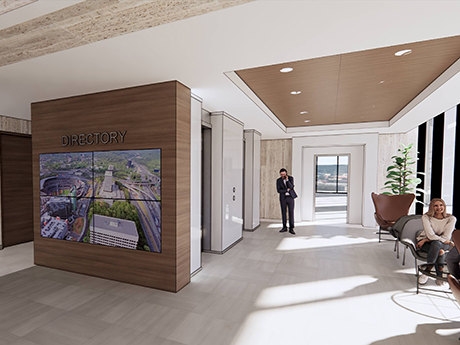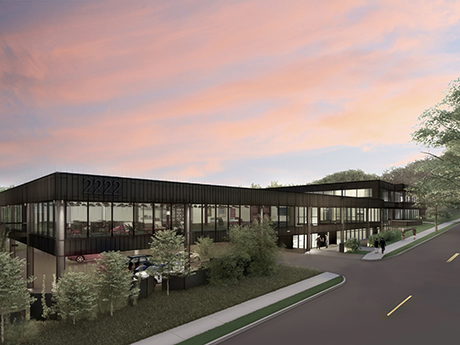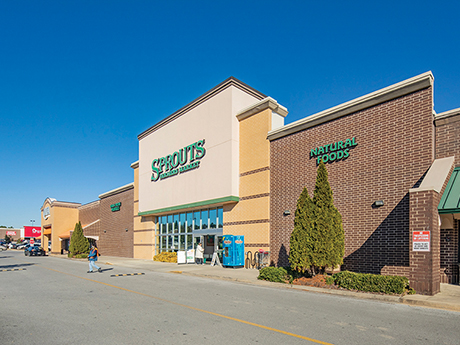In many ways, metro Atlanta is a tale of two office markets. Google, Microsoft, Papa John’s, Visa and FanDuel are just some of the heavy hitters that have signed major deals over the last year and a half, fueling leasing activity that is getting closer to pre-pandemic norms. Much of that action has been centered in the Central Business District (CBD), which registered a 68 percent year-over-year increase in leasing volume compared to first-quarter 2021. According to research from CoStar Group, leasing volume for the entire market totaled 3.2 million square feet in the first quarter, which is on par with the 10-year quarterly average. Midtown, where more than 2 million square feet of new product is under construction and the majority of corporate heavyweights have planted their flag, led all submarkets in leasing activity, with Cushman & Wakefield reporting nearly 314,000 square feet of new leases signed in the first quarter. Midtown’s overall walkability, abundance of high-rise residential units, new office buildings and access to talent from local universities and mass transit have enabled it to become a talent magnet for major employers and one of the nation’s premier submarkets. However, the vast majority of office tenants in metro …
Southeast Market Reports
While the Birmingham market never fluctuates too heavily in either direction, it typically remains relatively stable compared to national trends. Such has been the case with the effects of COVID-19. Birmingham is well-positioned for a return to the office, thanks in large part to our economy’s heavy makeup of local and regional businesses. Most smaller businesses have been in the office for some time, while large national enterprises still wrestle with what normal operations will look like moving forward. General market information Birmingham saw some positive absorption in 2021, with the occupancy rate holding steady at 81 percent, around the historical average. Birmingham comprises approximately 20 million square feet of office space with five main submarkets. Midtown, comprising mostly mid-size, Class A office buildings, remains the strongest submarket with an occupancy rate over 92 percent and rental rates in the mid to high $20s per square foot ($24.12 per square foot average). The Central Business District has seen companies leave for suburban submarkets like Midtown and Highway 280/Interstate 459, however the occupancy rate of 78 percent has remained relatively stable over the past couple of years, with rents in the low to mid $20s per square foot ($21.07 per square …
Like many of the markets within the Sun Belt, Birmingham’s economy remained relatively resilient through the emergence of the COVID-19 pandemic. Despite its share of small business and restaurant closures, leasing activity is back to par, and owners continue to see steadily rising rental rates — up 3.1 percent over the last 12 months — as tenant demand continues to be robust. Retail absorption over the last 12 months is a healthy 400,000 square feet compared to -510,000 square feet a year ago, which is a phenomenal 909,000-square-foot change just 18 months out from the emergence of the Coronavirus and effective shutdown of the U.S. economy. As Americans return to whatever the new normal is deemed to be and retail conditions continue to rebound, Birmingham is poised and ready to stake its claim in the South’s hierarchy of bourgeoning retail markets. Over the course of retail’s revival during the last 12 to 15 months, development has picked up throughout the Birmingham MSA, fueled primarily by build-to-suit projects for established chains in rapidly expanding suburban markets like Hoover. Stadium Trace Village, a master-planned, mixed-use development at Interstate 459 and Ala. Highway 150, has been one of the most recent projects to …
The Sun Belt is experiencing unprecedented growth with in-migration trends setting the stage for further expansion and bolstering in-place multifamily product. This includes Birmingham, which has weathered COVID-19 well not only from an employment perspective, but from a rent growth perspective too. The latter is not sustainable without the former, and local capital investments point to more tailwinds. Birmingham has been on the move, adding 60,000 jobs since April 2020 and becoming the primary driver of economic growth in Alabama. With the influx of new jobs, the city has surpassed its pre-pandemic peak and as a result, the city’s rent growth has outperformed the national average for several years. There was a short period where downtown rents and velocity fell off during the pandemic, but it came back fast and strong. Riding the tailwinds One notable example of in-migration, both investment and population wise, was when Landing announced it would be relocating its headquarters from San Francisco to Birmingham. Landing is a tech startup that provides access to a network of fully furnished apartments, and its move to the city is expected to create more than 800 direct, full-time jobs. The announcement was exciting locally as Birmingham presumably wouldn’t have …
After several years in the top 10, Nashville was named the No. 1 “market to watch” in overall commercial real estate prospects, according to Urban Land Institute and PwC’s 2022 Emerging Trends in Real Estate report. Nashville surpassed its supernova competitors (markets with a population between 1 million and 2 million people) such as Raleigh-Durham, Phoenix, Austin and Charlotte. The report credits Nashville’s robust and sustained job and population growth, above-average levels of economic diversity and investment/development opportunities. In short, Nashville’s economy fared relatively well during the pandemic-induced recession, and its industrial market never slowed down. Nashville has been a top location for relocating and expanding industrial-using companies, as its location is unmatched for distribution. Fifty percent of the nation’s population lives within 650 miles of Middle Tennessee, with 24 states falling within that radius. This translates to a one- or two-day truck delivery time to more than 75 percent of all U.S. markets. Additionally, it is one of only six U.S. cities with three major intersecting interstate highways. Nashville’s economy is extremely resilient due to its diversified economy. However, Nashville is not immune to national trends that have affected multiple industrial markets. The cost of construction continues to increase, …
Suburban household growth in metropolitan Nashville was already outpacing urban growth prior to the COVID-19 pandemic, but has accelerated since the outbreak due to corporate America’s acceptance of work-from-home staffing. Multifamily investors have followed this suburban household growth as well. Two recent examples are in Lebanon and Murfreesboro, both high-growth, high-quality suburbs of Nashville that have recently experienced record-setting transactions. The Pointe at Five Oaks recently sold for $243,000 per unit, setting a record for Lebanon. Vantage at Murfreesboro recently went under contract north of $270,000 per unit, also setting a record for Murfreesboro. We don’t see this activity and record-setting slowing down any time soon due to the lack of supply, overwhelming out of state demand and skyrocketing replacement costs. New multifamily development continues to follow the suburban trend, often times with a mixed-use component. Case in point, Highwoods Properties has completed the assemblage of all 145 acres of Ovation Franklin and is beginning the journey to reimagine and re-introduce one of the greatest opportunities for mixed-use development in the nation. This project will consist of 1.4 million square feet of Class A offices, 950 residential units, 480,000 square feet of retail and restaurants and 450 hotel rooms. Single-family …
After national media declared traditional brick and mortar retail to possibly be on it’s “last leg” due to the COVID-19 pandemic, the Nashville area has seem quite the opposite reaction. Already in an accelerated state of demand going into the shutdown of 2020 that extended into a malaise in 2021 in many places, Nashville is seeing all indicators of the hottest retail market in its history. Prior to the pandemic, rents and occupancy were already at historic highs. 2020 began with a continuance of that trend and ended the year higher with the most active submarkets closing the year below a 5 percent vacancy rate across all retail product types as the market absorbed more than 300,000 square feet of new product. During 2021, the region experienced further good news for landlords with rents increasing at one of the fastest rates in the United States (more than 8.8 percent). This continues a trend lasting more than 10 years where regional rent growth outpaced the national average. This growth was at least partially driven by a vacancy rate at year-end of only 3.7 percent. The primary driver of these metrics continues to be population growth and a low level of retail …
Raleigh-Durham is increasingly popping up at the top of shopping lists for multifamily investors, and buyer demand — coupled with strong rent growth — is resulting in record sale prices. As of this writing, 2021 is on pace to be one of the best years ever in terms of total transaction volume. As capital continues to flow into the market across the spectrum of investor groups from institutions to high net worth individuals, cap rates also have dropped into record territory. Just about every sale in the market is trading at a cap rate in the 3s, and even sub-3 percent in some cases. For example, Northmarq recently brokered the sale of the 489-unit Indigo Apartments in Morrisville on behalf of Blue Heron Asset Management. The asset sold for $121.9 million. The deal was one of the largest single-property multifamily sales in North Carolina in 2021, and the largest in Raleigh-Durham’s history upon closing. The property received multiple qualified offers before selling to Toronto-based Starlight Investments for $249,000 per unit, surpassing initial pricing guidance by nearly 20 percent. The phenomenon of lower return expectations and compressed cap rates is not unique to the Raleigh-Durham market. That trend is occurring throughout …
The I-40/I-85 Corridor is an emerging distribution area with a remarkably strong tenant mix between national manufacturers and distribution users, making it one of the most fundamentally sound corridors in the Sun Belt. The I-40/I-85 Corridor, squarely centered between the Triad (Greensboro, Winston-Salem and High Point) and the Triangle (Raleigh, Durham, Chapel Hill), is home to companies such as Walmart, Lidl, Ford, Kidde, Amazon, Chick-Fil-A, UPS, Lenovo, FedEx, Coca-Cola, among others. This corridor is seeing rapid expansion and is poised to be an epicenter of industrial activity in the region as the logistical significance of the area is attracting larger users and a growing amount of institutional capital. Recently, this submarket has seen significant demand from larger users leading speculative developers to plan large, Class A industrial parks. Historically, the market has been dominated by older manufacturing buildings. The newer development in the area is making these properties more obsolete due to their lower efficiencies, a phenomenon marking a larger shift in the composition of the emerging submarket. The industrial inventory’s makeup is continuing to evolve over time, marking the transition from smaller manufacturing properties to distribution and significantly larger manufacturing operations. Buildings currently under construction are average a footprint …
The Raleigh-Durham region is experiencing increasing optimism despite the lingering impacts of COVID-19. While some reentry plans have been delayed and companies are still grappling with the way in which they will utilize office space moving forward, tenant demand is expected to rebound sharply in the first half of 2022. “We’ve seen an encouraging uptick in tenant activity since the second quarter of 2021, and we expect that trend to accelerate,” says Kathy Gigac, principal of Avison Young and a member of the firm’s Occupier Solutions Team. “Tenants seem ready to get back to some sense of normalcy.” Local economic fundamentals are sound, as reopening efforts and positive job growth have allowed Raleigh-Durham’s unemployment rate to recover from a pandemic high of 12 percent to 3.2 percent as of Sept. 2021. The region continues to witness major economic development wins with companies such as Google and Apple announcing plans to create thousands of new jobs. In its largest presence on the East Coast, Apple will invest $1 billion over a 10-year period to create a 3,000-job campus to eventually span 1 million square feet. In the most recent announcement from an office-using tenant, Fidelity Investments will add 1,500 jobs in …








